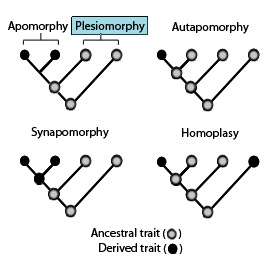Symplesiomorphy

In phylogenetics, a plesiomorphy, symplesiomorphy or symplesiomorphic character is an ancestral character or trait state shared by two or more taxa. A plesiomorphy refers to the ancestral trait state, usually in reference to a derived trait state. A symplesiomorphic trait is also shared with other taxa that have an earlier last common ancestor with the taxa under consideration. They are therefore not an indication that the taxa be considered more closely related to each other than to the more distant taxa, as all share the more ancestral character state.[2] The term symplesiomorphy was first introduced in 1950 by German entomologist Willi Hennig.
Discussion
The concept of plesiomorphy shows the perils of grouping species together purely on the basis of morphologic or genetic similarity without distinguishing ancestral from derived character states. Since a plesiomorphic character inherited from a common ancestor can appear anywhere in a phylogenetic tree, its presence cannot reveal anything about the relationships within that tree.[3]
A famous example is the trait of breathing via gills in bony fish and cartilaginous fish. Bony fish are more closely related to terrestrial vertebrates, which evolved out of a clade of bony fishes that breathe through their skin or lungs, than they are to the sharks, rays, and the other cartilaginous fish. Their kind of gill respiration is shared by the "fishes" because it was present in their common ancestor and lost in the other living vertebrates. But based on this shared trait, we cannot infer that bony fish are more closely related to sharks and rays than they are to terrestrial vertebrates.[4]
See also
References
- ↑ Roderick D.M. Page; Edward C. Holmes (14 July 2009). Molecular Evolution: A Phylogenetic Approach. John Wiley & Sons. ISBN 978-1-4443-1336-9.
- ↑ Futuyma, Douglas J. (1998), Evolutionary Biology (3rd ed.), Sunderland, Massachusetts: Sinauer Associates, Inc., p. 95, ISBN 0-87893-189-9
- ↑ Patterson, Colin (1982), "Morphological characters and homology", in Joysey, Kenneth A; Friday, A. E., Problems in Phylogenetic Reconstruction, Systematics Association Special Volume 21, London: Academic Press, ISBN 0-12-391250-4.
- ↑ Cracraft, Joel; Donoghue, Michael J. (2004), Assembling the Tree of Life, USA: Oxford University Press, p. 367, ISBN 0-19-517234-5
| ||||||||||||||||||||||||||||||